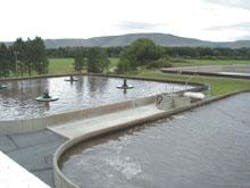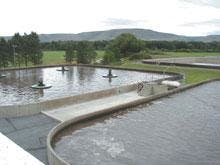Motor management saves energy costs in treatment facilities
By Ted Jones
Electric bills are a major operating expense for most water and wastewater facilities. Since motor systems, such as pumps, dominate consumption, they offer a major opportunity for energy savings without sacrificing facility performance
Water and wastewater treatment facilities account for three percent of electricity use in the USA at a cost of some US$ 6.5 billion annually. Pumping accounts for over 95% of total electricity use in these facilities, with 85% consumed by distribution pumping. In wastewater facilities, blowers for aeration of activated sludge account for half the electricity, and pumping for 15%.
In 1998, the US Department of Energy estimated that greater attention to motor system management can reduce industrial energy consumption by 18% on average. Because motors play such a dominate role in facility operations, the potential for energy savings through motor system efficiency is even greater with some plants saving as much as 40 percent on energy costs. With the current economic climate putting a squeeze on state and municipal budgets, now is the time to improve the efficiency and productivity of existing motor systems, such as pumps, fans and air compressors.
Two effective ways are recommended to help facility managers tap into these savings — installing NEMA Premium™ efficiency motors and developing motor management plans. Motor management consists of a variety of practices that capitalise on the benefits of premium-efficiency motors (lower operating costs and improved reliability) and best motor repair practices (maintaining efficiency, optimal availability). It includes:
• A decision-making protocol based on life cycle costing for making purchase and repair/replace decisions.
• Procedures to inventory and categorise motors.
• Practical advice on making sure that the optimal motor for critical applications will be available when needed.
• Guidelines to ensure quality repair services.
Over a motor's lifetime, its electric bill accounts for more than 97% of its total cost. Less than three percent of the lifetime cost goes toward its purchase, installation and repair. For example, the typical purchase price of a typical 75-hp motor is about US$ 4,000. Running at full load for 6,000 hours per year over its 10-year life, however, that same motor will cost US$ 220,000 to run (based on US$ .075 per kWh). Obviously, small increases in efficiency translate into big savings. In this example, a one percent increase in motor efficiency translates into US$ 2,800 in energy savings over that time - nearly the cost of the motor.
Implementing a motor management plan can often improve productivity and energy efficiency. The first step to implementing a plan is to understand and catalogue the motor fleet. One of the benefits of this review process is that it quickly identifies process equipment with older, inefficient motors and improperly sized motors that should be replaced based on their economic performance. Economic analysis will also indicate whether these motors should be replaced immediately or upon failure. Plants that have large motors and motors running critical processes have the most to gain from the review in terms of economic return and reduced downtime.
Identifying appropriate applications for premium-efficiency motors is an important component of every motor management plan. Understanding what motor efficiency levels are available and how to specify them is equally important. To ease this process, a premium-efficiency specification and brand, called NEMA Premium™, has been established that motor manufacturers, distributors, repair shops, energy efficiency organisations, and motor incentive program administrators, now embrace. For more information, see www.nema.org/ premiummotors.
Finally, motor management is about planning. Too often, repair/replace decisions are based on motor availability or short-term economics, not long-range planning. Motor management provides financial analysis tools to help make good motor decisions and offers direction for developing cost-effective, pro-active purchasing and repair/replace policies. The Motor Decisions Matter website (www.motorsmatter.org) offers a motor planning toolkit to help start a development plan.
Where are the savings?
According to industry sources, nearly 40 percent of drinking water systems with surface water sources need to build, rebuild, or make significant improvements at their facilities. Proper equipment selection and management can lead to major savings for new and expanded facilities, or when equipment fails in existing facilities. For example, with a 50-hp 1,800-rpm vertical shaft motor, choosing a NEMA Premium efficiency model will save almost US$ 1,600 per year over an average efficiency model. With a cost premium of US$ 525 over a standard motor, simple payback is less than seven months, and the rate of return (IRR) is 175%. The net present value of the incremental investment is US$ 4,330 over a 10-year horizon (15% discount rate). This type of economic performance represents a significant savings opportunity. Unfortunately these savings are too easy to miss in an operating environment that focuses on regulatory compliance, meeting future demand, and now, heightened security. Motor efficiency opportunities are widely available at many water supply and wastewater treatment facilities, falling into three basic levels: operations, component and systems.
Efficiency measures at the operations level may be undertaken at little or no cost. Facilities personnel can perform monitoring and maintenance on equipment to increase system efficiency and prolong equipment life. Temperature and ventilation can also affect motor efficiency, and motor and pump manufacturers should be able to provide information to facilities personnel about optimum operating conditions. Money can be saved if facilities personnel undertake a few of the preliminary steps that engineers would otherwise handle. These include measuring system pressures, using flow meters to determine flow rates, and sketching pump systems with elevations. Facilities staff can undertake all of these preliminary information-gathering components of the engineering analysis prior to the engineer's involvement.
Replacing Inefficient Motors
Component level measures involve replacing standard motors with their energy efficient counterparts. Measures at this level present significant potential energy savings for this industry. One of the best opportunities to install energy efficient motors is when water supply facilities purchase new motors as a result of existing motor failure and when expanding facility size or capacity. A repair motor centre/distributor can assist in developing customised motor plans that will help determine whether it is most cost effective to repair a motor or replace it with a higher efficiency model.
Initial purchasing costs are generally higher for NEMA Premium motors because they have longer insulation and bearings lives, lower heat output, less vibration, and are more tolerant of overload conditions and phase imbalance than their standard efficiency counterparts. As a result, NEMA Premium motors have lower failure rates, therefore manufacturers generally provide longer warranties for their energy efficient lines.
Systems Level Savings Measures
When implementing efficiency measures, all of a system's components should be considered, rather than just viewing motor systems as a distinct part of the operating system. Adjustments to "tune up" pumps and other motor systems usually have little cost and may achieve significant efficiency improvements, even without purchasing new motor equipment. Because motors typically have highest efficiency at 70 to 90 percent of their maximum loads, effectively matching motors to loads will result in substantial energy savings.
An analysis of system efficiency may reveal opportunities to install variable frequency drives (VFDs). A VFD is an electronic control device that modulates the amount of power being delivered to a motor to allow for continuous matching of motor speed to the demands of varying flow and may be used to increase motor efficiency in water supply facilities. These devices accommodate fluctuating demand by running pumps at lower speeds and requiring less energy while more accurately meeting pump needs. Therefore, system-wide efficiency measures can result in enormous savings in both money and energy.
The Inland Empire Utilities Agency upgraded the pumping systems at its Ontario, California regional wastewater treatment plant. In order to battle back against rising energy costs, the plant evaluated the treatment plant's pumping system to determine whether efficiency gains and energy savings were possible. The evaluation led the plant to implement a system-level project that removed eddy current clutches for many pumps and retrofitted most of the plant's pumps with high efficiency motors. The retrofit resulted in projected annual energy and maintenance savings of $71,000 and an energy savings of 475,000 kWh, which represents 10 percent of the electricity used by that process. With a total cost of $188,000, and a $15,000 grant from the California Energy Commission, the payback on the motors is just over 26 months. A case study is available on the MDM website, www.motorsmatter.org.
South Essex Sewerage District in Salem, Massachusetts has also taken an aggressive approach to motor management. District officials are in the process of evaluating and monitoring all of the district's 2,000 electric motors. From this evaluation, district officials plan to replace upwards of 100 motors with NEMA Premium models.
Managers at the Ellensburg Wastewater Treatment Plant of Ellensburg, Washington, USA, were faced with an expensive decision. Do they rewind or replace two large 50- hp aerator motors that had failed? Using MotorMaster + 3.0 software to analyse the two alternatives, managers concluded that it was more cost effective to purchase new motors rather than to rewind the existing motors. By using motor management, managers were able to make a confident decision to replace the older, inefficient motors with new, standard motors at an energy savings of US$ 1,650 over the life of each motor.
Motor Decisions Matter, a US educational campaign, promotes the benefits of motor management and premium-efficiency motors and helps companies adopt these practices. Campaign sponsors include motor manufacturers, utilities, energy efficiency organisations, trade associations and government agencies. For more information, see www.motorsmatter.org.
Author's NoteTed Jones is the program manager of the Consortium For Energy Efficiency (CEE) and manager of the MDM campaign, based in Boston, Massachusetts, USA.

